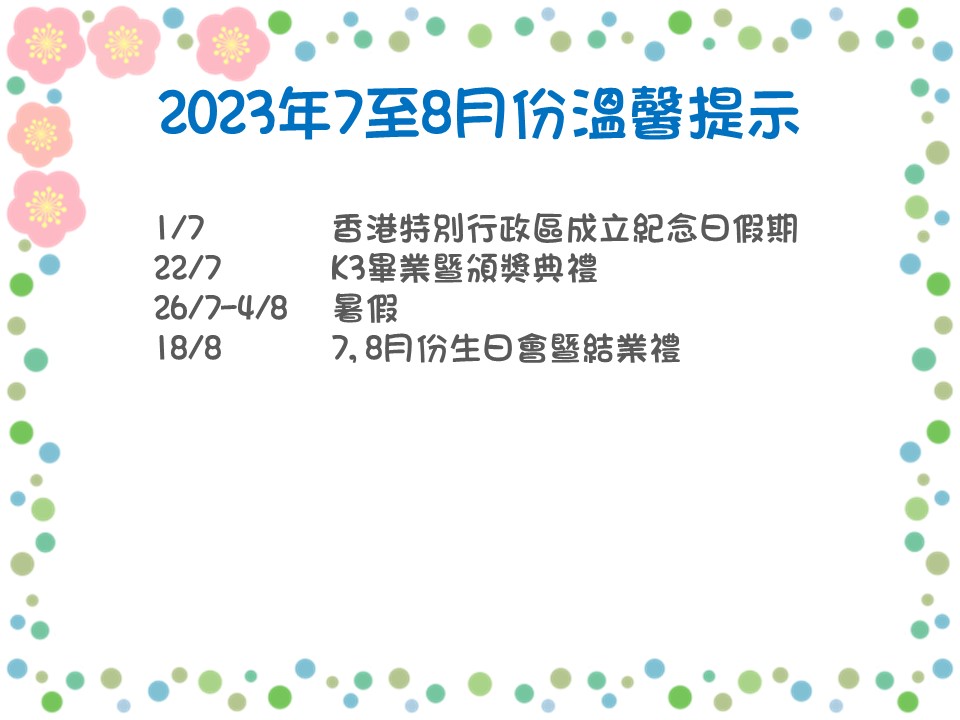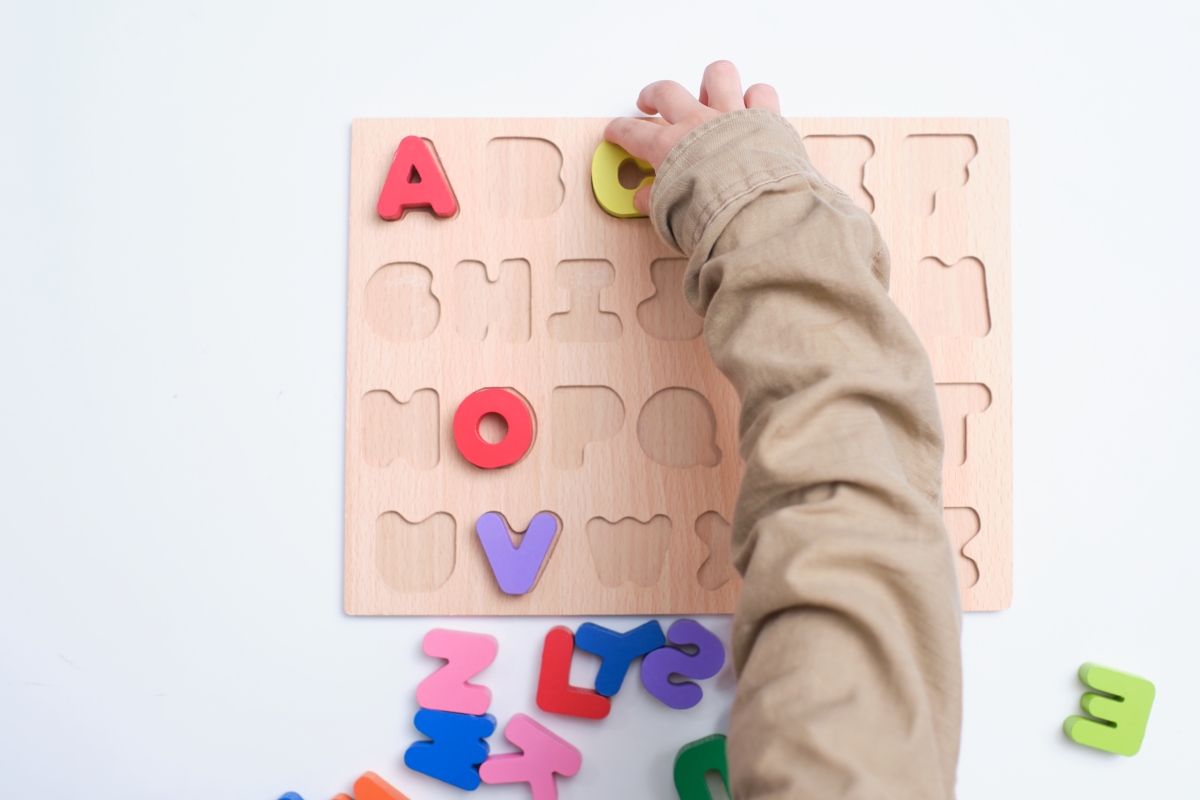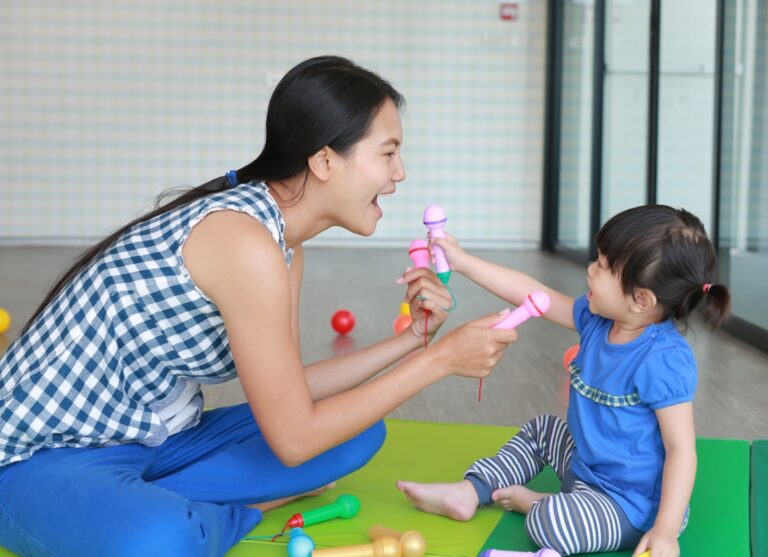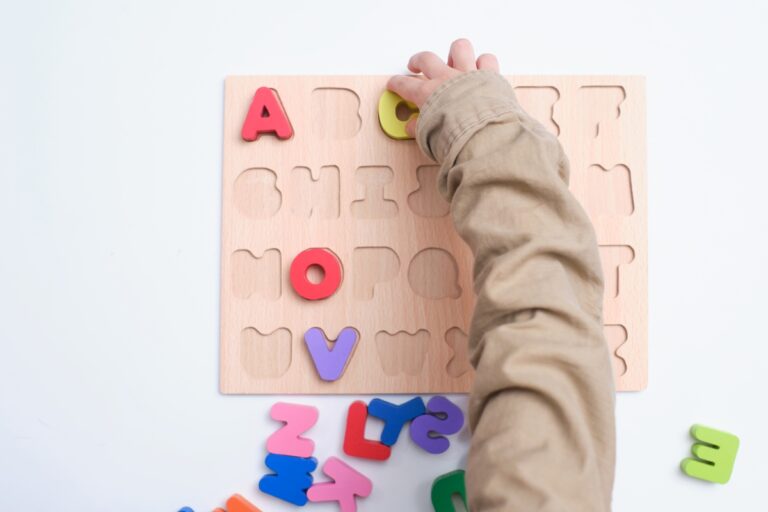Jul-Aug 2023 Reminder


1) 1/7 香港特別行政區成立紀念日假期
2) 22/7 K3畢業暨頒獎典禮
3) 26/7-4/8 暑假
4) 18/8 7,8月份生日會暨結業禮


Source: Speech Therapist, Miss Carley
In order to help children learn a language, parents use various methods. Have you ever considered singing as one of the methods? Music is an international language and is highly engaging for children. We also have many different ways to use music to assist children in language learning.
One simple method is called “lyric filling.” This method can be used for children who may not yet be able to speak or can only say a few words. Parents can try using this method. Choose a familiar song that the child knows, such as “Twinkle Twinkle Little Star.” However, instead of singing the entire song, use a single syllable to sing the entire song, for example, “ma ma ma ma ma ma ma ma ma ma ma ma ma.” Then suddenly stop and wait for the child to hum or sing the remaining syllable. Parents can encourage the child to vocalize that particular syllable.

The second method is to sing action songs with children, which involve movements. For example, the well-known song “If You’re happy and you know it, clap your hands.” You can sing this song with the child while performing different actions. Through this, children can learn different movements and some nouns and vocabulary.
Interestingly, music can enhance children’s memory. Have you ever noticed that there are many songs we heard when we were young or many years ago, and even if we haven’t sung them in years, we can still remember the lyrics? Therefore, we can simply sing the ABC Song with children to teach them basic English letters. We can also learn numbers with children, for example, “One Little, Two Little, Three Little Indians.”

If we want to teach children the English names of the days of the week, we can sing “Monday, Tuesday, Wednesday, Thursday, Friday, Saturday, and Sunday” with them. By incorporating vocabulary into music, it makes it easier for children to remember the words.
The fourth method is to try singing out certain phrases, similar to singing. We can also use props to assist, such as simple flashcards. For example, if we want to say, “Chan Siu Ming is eating an apple,” we can sing it out using a musical approach, which enhances the child’s motivation and interest in communication.


Written by: Marriage and Family Therapist, Child Play Therapist, Lee Wai Chee
Everyone hopes to find happiness, and parents are certainly no exception. Many times, parents are even willing to sacrifice their own immediate needs and happiness, hoping to exchange them for their children’s “happy life” in the future.
Most parents understand that their children’s future “happiness” is by no means guaranteed one hundred percent. However, many parents believe that not striving today will inevitably lead to failure tomorrow. In addition, the social atmosphere advocates “doing more is better than doing less,” and even considers not doing anything as laziness and passivity. As a result, all parents and children find themselves doing more and more, gradually losing their direction.
In online discussion forums, I often see some parents criticizing society and the education system for putting excessive pressure on children, stifling their growth space. However, on the other hand, they helplessly push their children to do various exercises every day, showing their helplessness and sense of powerlessness. The contradictions and dilemmas faced by parents are understandable, but these fears and anxieties can cause parents to easily miss the insights that children give us.

When a baby is born, they live a simple, direct, and natural life every day. When they are hungry, they eat; when they are full, they sleep; and when they wake up, they play. They explore the world in their own way and interact with the people around them. They laugh heartily when they are happy and cry out loudly when they are sad. Children tell us that human needs are actually quite simple, and as long as these needs are satisfied, they will be happy. It’s just that the adult world has become increasingly complex, and people’s desires have grown, causing adults to forget even their own needs and, as a result, become increasingly unhappy. Ironically, we still assume that we understand the “key” to a “happy life” and teach children how to find happiness.
Today’s society is filled with the anxiety and unease of adults who fear being marginalized by society and worry that their stable lives are threatened. As parents, they are even more concerned about their children’s future lives. In fact, children understand the essence of happiness best because they naturally live freely and at ease. However, somewhere along the way, parents hope that their children can adapt to the distorted rules of the real world as soon as possible, inadvertently erasing their natural and childlike qualities.
A child’s growth takes time. If parents can observe their lives with a calm mind, be patient, slow down, and enjoy every moment spent with their children, they may rediscover that happiness is not in the future but in the present moment.
Address: G/F WING B & C, SAU YUE HOUSE SAU MAU PING ESTATE KOWLOON
Fax: +852 2709 9269